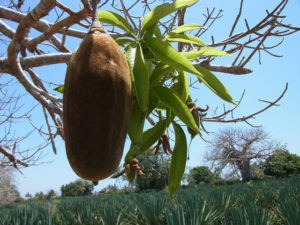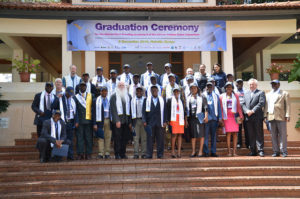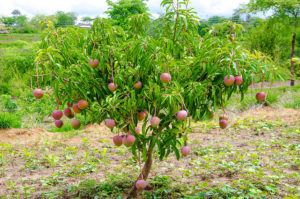
Orphan crops, so-called because they are considered neglected and underutilized, are typically overlooked in terms of resources for their promotion. But they are now being brought out of the shadows, along with their potential health and environmental benefits.
At present, orphan crops are not extensively researched, despite their potential for realizing economic and dietary benefits for the people who cultivate and consume them, as well as bringing environmental gains to the landscapes where they are grown.
This is due in part to the “nonstandard and unimproved” landraces being grown in some locations, which are not as productive, robust or of as high quality as they could be. However, through plant genetics and crop improvement, the potential of orphan crops to address issues of malnutrition and hunger in Africa can be enhanced, if the necessary market interventions to support their use are also correctly implemented.
The African Orphan Crops Consortium (AOCC), which aims to obtain complete sequences of DNA of 101 neglected food crops, and the African Plant Breeding Academy (AfPBA), which empowers crop breeders from across Africa through skill development, networking and information sharing, are working to improve these crops and promote their utilization.
The AOCC, based in Nairobi and launched in 2011, is hosted by the World Agroforestry Centre (ICRAF), one of the CGIAR Research Program on Forests, Trees and Agroforestry’s (FTA) partner institutions. Its research is now in the spotlight following recent articles from The Economist and the Financial Times.
According to ICRAF’s Prasad Hendre, the Genomics Laboratory Manager at the AOCC, the consortium is “all about giving a voice to underprivileged African farmers through their crops, making the crops sustainably profitable for individual smallholder farmers, their families and communities.”

So far, of the overall target, AOCC researchers have fully sequenced 10 genomes and partially sequenced 19.
“The AOCC is working on 101 orphan crops – 50 trees and 51 annuals – shortlisted through larger consensus between farmers, policy makers, governments, agricultural research organizations, philanthropists and private entities,” Hendre said.
“As a first step, we are trying to bring scientific equality to these crops by making the cutting-edge application-oriented scientific tools available through group leadership of the AOCC. It is all about bringing useful and innovative technology to the doorsteps of the African research community, primarily the plant breeders, who can develop new varieties to suit local, regional and global demands.
“At the core of these technologies is the genome sequence of any crop, which directly or indirectly shapes the outcome of these crops on farms. By predicting the effect of a specific DNA signature on the performance of an individual, it is possible to design a next generation of ‘smart’ crops which are high yielding, efficient, highly nutritious and capable of facing environmental challenges. It is also important to impart the right skillsets to African plant breeders who are largely practicing traditional methods of crop improvement. The new tools and methods in their hands can speed up variety development.”
AfPBA, an initiative of the AOCC, is focusing on this skill enhancement by training African plant breeders to use genomic tools and incorporate them into breeding programs.
Mehmood Hassan of ICRAF, who is also FTA’s capacity development coordinator, explained that AfPBA is a collaboration between the University of California, Davis and ICRAF, while the New Partnership for Africa’s Development and the Alliance for a Green Revolution in Africa are also closely involved.
The academy aims to equip 250 African breeders with advanced breeding skills and approaches by 2023 and to expand their horizons to incorporate African orphan crops, including trees, into their breeding agendas, according to Hassan. So far, more than 50 breeders in two groups have successfully graduated, with a third group of 34 set to graduate in June 2018.

“Several of the past graduates have already influenced breeding programs by expanding the focus from calorific crops to crops with wider nutritional value,” Hassan said.
AfPBA also mentors the trainee breeders in formulating international grant proposals. A few breeders have already been able to attract additional financial resources to support and expand their programs to include some of these new tools.
“The benefits of breeding these crops will be many,” said Hendre. “For local African orphan fruit tree crops, an additional benefit could be their conservation, encouraging farmers to plant highly productive varieties on farms in a sustainable manner, as compared to extractive non-sustainable harvesting from parklands, semi-wild or forest landscapes.”
“For annuals, it will help in improving their acceptance as mainstream crops due to developing easy to cook, easy to cultivate, tasty and nutritious high-yielding varieties,” he added.
For both trees and annual crops, the primary beneficiaries are expected to be farmers, who will be able to diversify their farms with multiple marketable options made available through newly developed varieties. Certified seed sellers are also likely to be among the primary beneficiaries.
Meanwhile, secondary beneficiaries will include local traders, who will be able to buy and sell the products. Tertiary beneficiaries will be both local and global food processors, who will have the chance to diversify their offerings with nutritious, sustainable and locally sourced foods.
In line with this, once improved crops are bred, both farmers and seed distributors need to be encouraged to make use of them.
“Farmers can be encouraged to adopt new varieties if they are shown benefits. The most important benefit a farmer can see is through increased income. ICRAF and FTA can help farmers see that there is a demand for their products and how they can use that opportunity to market their farm produce and enhance income,” said Hendre. “Other benefits for the environment and human health can be shown using ecological and health indicators for soil, climate and community health, among others.”

“Adopting improved varieties requires engaging with certified producers of planting material – be this seed or vegetatively propagated plants in the case of some crops – who can supply improved varieties to the farmers,” he added.
The prospects look good, with some orphan crops holding significant potential for wider consumption and improved nutrition.
“A few of these crops already have global or regional markets, such as African eggplant, African bush pear and African bush mango, Allanblackia, amaranth, baobab, marula, moringa and shea. Releasing improved varieties helps farmers to follow more profitable and sustainable cultivation practices, and allows product standardization, which lead to greater demand and better market prices. In the future, I can see many more of these crops reaching a global market as global consumer preferences change,” Hendre said.
With these efforts and the promising progress to date, new and improved varieties of orphan crops may one day sit alongside current staple foods in stores and on plates, both across Africa and around the world.
By Hannah Maddison-Harris, FTA Communications and Editorial Coordinator
This work forms part of the CGIAR Research Program on Forests, Trees and Agroforestry (FTA), which is supported by CGIAR Fund Donors.











